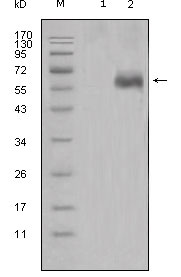Dkk-1 Monoclonal Antibody
- Catalog No.:YM0198
- Applications:WB;ELISA
- Reactivity:Human
- Target:
- Dkk-1
- Fields:
- >>Wnt signaling pathway;>>Alzheimer disease;>>Pathways of neurodegeneration - multiple diseases
- Gene Name:
- DKK1
- Protein Name:
- Dickkopf-related protein 1
- Human Gene Id:
- 22943
- Human Swiss Prot No:
- O94907
- Mouse Swiss Prot No:
- O54908
- Immunogen:
- Purified recombinant fragment of Dkk-1 expressed in E. Coli.
- Specificity:
- Dkk-1 Monoclonal Antibody detects endogenous levels of Dkk-1 protein.
- Formulation:
- Liquid in PBS containing 50% glycerol, 0.5% BSA and 0.02% sodium azide.
- Source:
- Monoclonal, Mouse
- Dilution:
- WB 1:500 - 1:2000. ELISA: 1:10000. Not yet tested in other applications.
- Purification:
- Affinity purification
- Storage Stability:
- -15°C to -25°C/1 year(Do not lower than -25°C)
- Other Name:
- DKK1;Dickkopf-related protein 1;Dickkopf-1;Dkk-1;hDkk-1;SK
- Molecular Weight(Da):
- 29kD
- References:
- 1. Dev Cell. 2008 Jul;15(1):37-48.
2. Cancer Lett. 2008 Sep 28;269(1):67-77.
- Background:
- This gene encodes a protein that is a member of the dickkopf family. It is a secreted protein with two cysteine rich regions and is involved in embryonic development through its inhibition of the WNT signaling pathway. Elevated levels of DKK1 in bone marrow plasma and peripheral blood is associated with the presence of osteolytic bone lesions in patients with multiple myeloma. [provided by RefSeq, Jul 2008],
- Function:
- function:Inhibitor of Wnt signaling pathway.,similarity:Belongs to the dickkopf family.,tissue specificity:Placenta.,
- Subcellular Location:
- Secreted.
- Expression:
- Placenta.
- June 19-2018
- WESTERN IMMUNOBLOTTING PROTOCOL
- June 19-2018
- IMMUNOHISTOCHEMISTRY-PARAFFIN PROTOCOL
- June 19-2018
- IMMUNOFLUORESCENCE PROTOCOL
- September 08-2020
- FLOW-CYTOMEYRT-PROTOCOL
- May 20-2022
- Cell-Based ELISA│解您多样本WB检测之困扰
- July 13-2018
- CELL-BASED-ELISA-PROTOCOL-FOR-ACETYL-PROTEIN
- July 13-2018
- CELL-BASED-ELISA-PROTOCOL-FOR-PHOSPHO-PROTEIN
- July 13-2018
- Antibody-FAQs
- Products Images

- Western Blot analysis using Dkk-1 Monoclonal Antibody against HEK293 (1) and DKK1-hIgGFc transfected HEK293 cell lysate (2).



